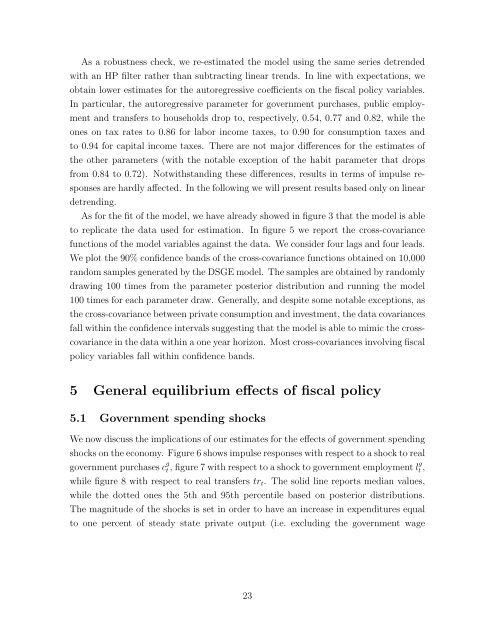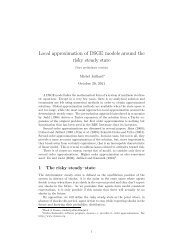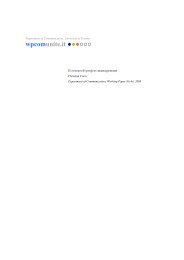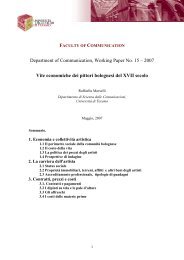Overall, most parameters seem to be well identified, as shown by the fact thateither the posterior distribution is not centered on the prior or it is centered but with asmaller dispersion. Some parameters however are not: this is the case for those relatedto investment adjustment cost, s ′′ , the monetary response to inflation, ρ π , and to acertain degree the parameters capturing the response <strong>of</strong> the consumption and capitalincome tax rates to the debt level. <strong>The</strong> fact that the labor income tax rate coefficienton debt seems to be well identified is not surprising, as labor income tax rates includesocial security contributions, that have been increasing in the last twenty years inorder to keep under control social security deficits (which have been an importantdeterminant <strong>of</strong> public debt growth in most European countries).Right columns <strong>of</strong> table 1 summarize estimated means and standard deviations fora selection <strong>of</strong> the parameters.<strong>The</strong> top panel reports estimates for preference andtechnology ones. <strong>The</strong> estimated fraction <strong>of</strong> non-Ricardian households γ turns out tobe 0.38, which is higher than in CS but not so high as to reach more than half <strong>of</strong> thepopulation as in the U.S. estimate <strong>of</strong> Campbell-Mankiw (1989).Among preference parameters, those related to risk aversion, σ c , habit, h, and theelasticity <strong>of</strong> labor supply with respect to real wage, 1/σ l , are estimated to be higherwith respect to both SW and CS. Also the elasticity <strong>of</strong> labor demand with respect tothe real wage, θ L , is estimated to be quite higher than the calibrated value <strong>of</strong> SW andCS, implying a much lower steady state wage markup, at about 20%.With respect to both SW and CS, the estimate for price stickiness confirms the resultthat it exceeds the one <strong>of</strong> wages by a factor <strong>of</strong> three. Based on a Rotemberg-Calvoequivalence, it can be computed as a price duration <strong>of</strong> about 8 quarters, i.e. lower thanin the two above papers, though comparable with the estimate in Galí et al. (2001).Estimated <strong>policy</strong> coefficients feature, on the monetary side, a lower smoothing anda higher weight on inflation and, particularly, on inflation change with respect to bothSW and CS. On the <strong>fiscal</strong> side, tax rate processes appear to be highly persistent,although the reaction to debt is quite sizeable and large enough to be stabilizing. <strong>The</strong>autoregressive parameter for government purchases, public employment and transfersto households are estimated at respectively 0.87, 0.97 and 0.96 (levels similar to theone estimated for government consumption G by both SW and CS), pointing to a highpersistence <strong>of</strong> <strong>fiscal</strong> <strong>policy</strong> innovations.number <strong>of</strong> the Hessian, the covariance among parameters implicit in the estimated Hessian and plottedslices <strong>of</strong> the likelihood around the mode. <strong>The</strong> Hessian is in <strong>general</strong> well conditioned and does not implyany correlation among parameters higher that 0.8, and the likelihood at the mode shows a significantcurvature for almost all parameters. This latter result, in particular, is evidence <strong>of</strong> the fact that thedata contain useful information to identify the parameters.22
As a robustness check, we re-estimated the model using the same series detrendedwith an HP filter rather than subtracting linear trends. In line with expectations, weobtain lower estimates for the autoregressive coefficients on the <strong>fiscal</strong> <strong>policy</strong> variables.In particular, the autoregressive parameter for government purchases, public employmentand transfers to households drop to, respectively, 0.54, 0.77 and 0.82, while theones on tax rates to 0.86 for labor income taxes, to 0.90 for consumption taxes andto 0.94 for capital income taxes. <strong>The</strong>re are not major differences for the estimates <strong>of</strong>the other parameters (with the notable exception <strong>of</strong> the habit parameter that dropsfrom 0.84 to 0.72). Notwithstanding these differences, results in terms <strong>of</strong> impulse responsesare hardly affected. In the following we will present results based only on lineardetrending.As for the fit <strong>of</strong> the model, we have already showed in figure 3 that the model is ableto replicate the data used for estimation. In figure 5 we report the cross-covariancefunctions <strong>of</strong> the model variables against the data. We consider four lags and four leads.We plot the 90% confidence bands <strong>of</strong> the cross-covariance functions obtained on 10,000random samples generated by the DSGE model. <strong>The</strong> samples are obtained by randomlydrawing 100 times from the parameter posterior distribution and running the model100 times for each parameter draw. Generally, and despite some notable exceptions, asthe cross-covariance between private consumption and investment, the data covariancesfall within the confidence intervals suggesting that the model is able to mimic the crosscovariancein the data within a one year horizon. Most cross-covariances involving <strong>fiscal</strong><strong>policy</strong> variables fall within confidence bands.5 General <strong>equilibrium</strong> <strong>effects</strong> <strong>of</strong> <strong>fiscal</strong> <strong>policy</strong>5.1 Government spending shocksWe now discuss the implications <strong>of</strong> our estimates for the <strong>effects</strong> <strong>of</strong> government spendingshocks on the economy. Figure 6 shows impulse responses with respect to a shock to realgovernment purchases c g t , figure 7 with respect to a shock to government employment l g t ,while figure 8 with respect to real transfers tr t . <strong>The</strong> solid line reports median values,while the dotted ones the 5th and 95th percentile based on posterior distributions.<strong>The</strong> magnitude <strong>of</strong> the shocks is set in order to have an increase in expenditures equalto one percent <strong>of</strong> steady state private output (i.e. excluding the government wage23





